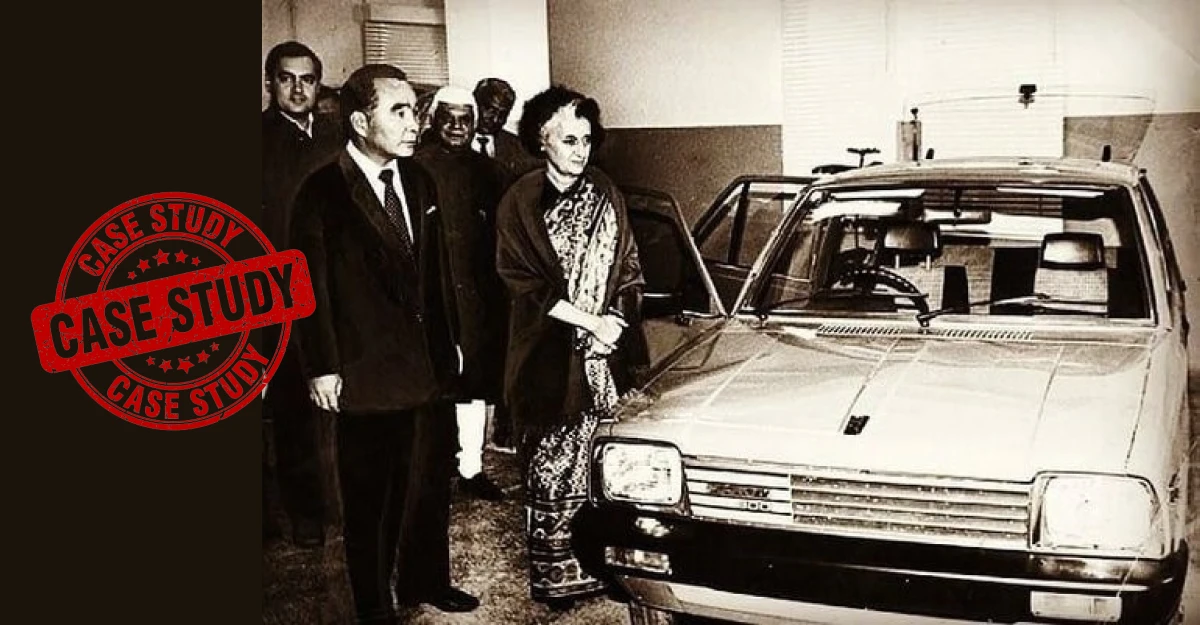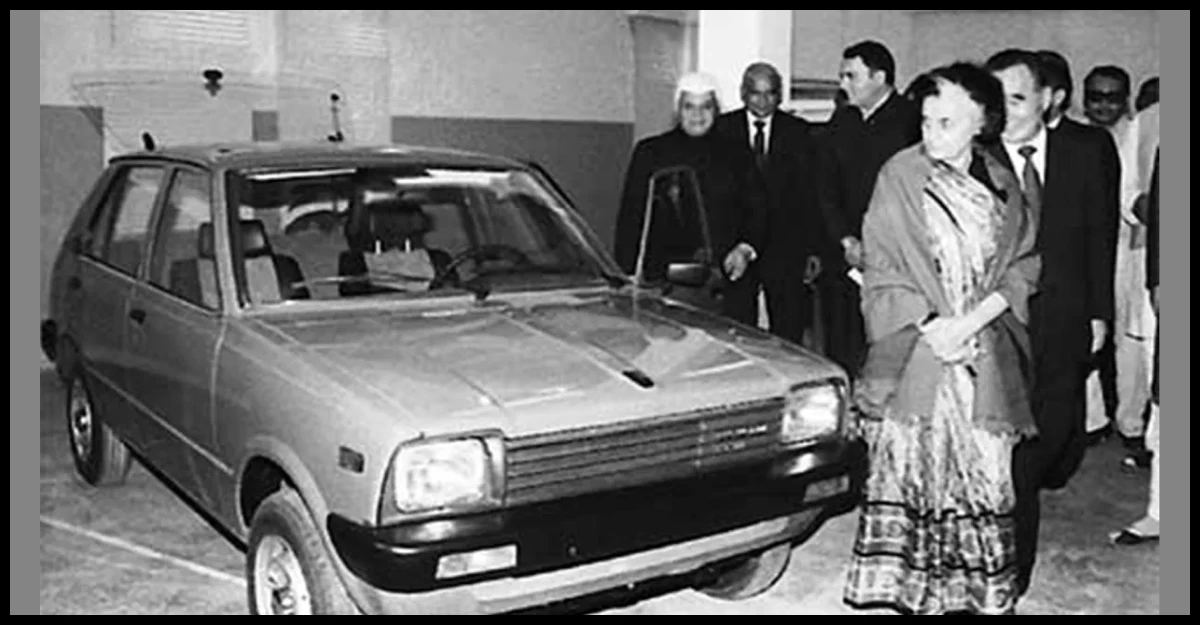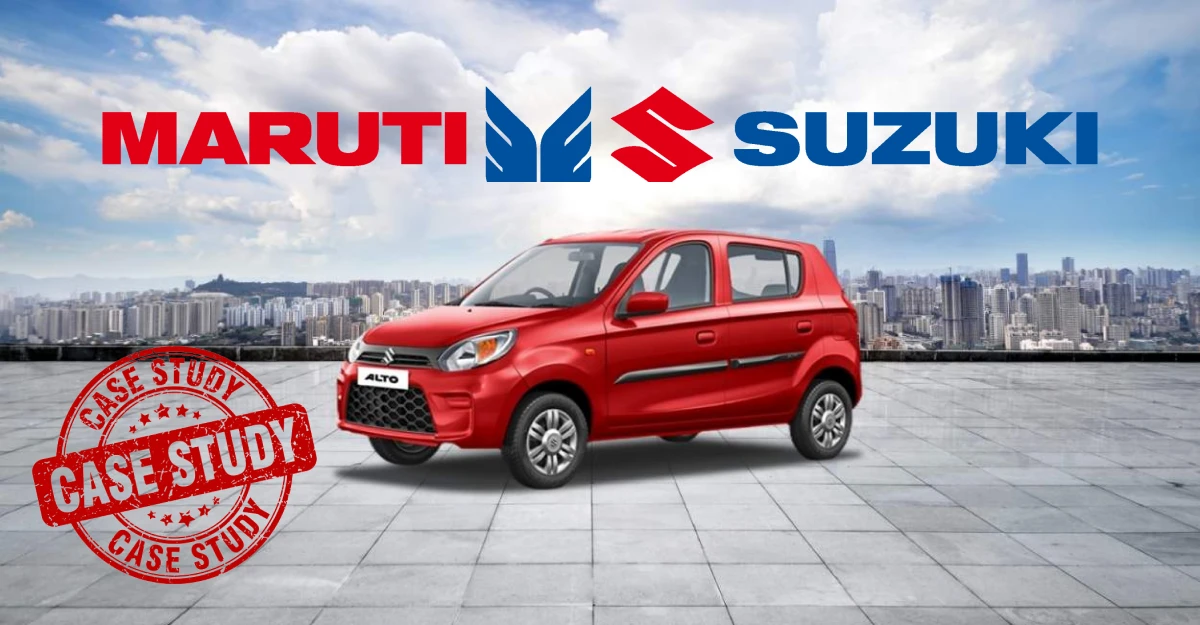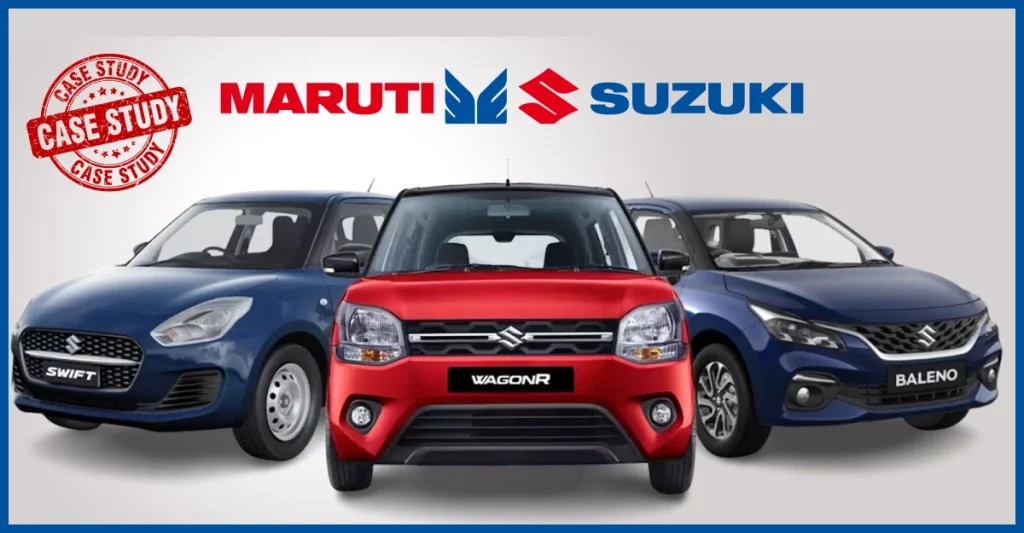In India, Maruti Suzuki is considered the market leader that revolutionized our automotive industry. After all, it’s not a cakewalk for an automobile brand to reign over four decades successfully. Don’t you wonder how it achieved this success?

So here, we are presenting the Maruti Suzuki case study to dive into various aspects that contributed to its success in India.
Stay tuned!
(A) Maruti Suzuki: Company Highlights
Maruti Suzuki India Limited, once called Maruti Udyog Limited, is the Indian part (subsidiary) of a Japanese car company called Suzuki Motor Corporation. In September 2022, they were the biggest seller of cars in India, with 42 percent of the market.
Before diving deeper into the Maruti Suzuki Case Study, let’s have a look at the company’s profile-
| Company’s Name | Maruti Suzuki India Limited |
| Former Name | Maruti Udyog Limited |
| Type of Company | Public & Subsidiary |
| Parent Company | Suzuki Motor Corporation |
| Traded as | BSE: 532500NSE: MARUTI BSE SENSEX Constituent NSE NIFTY 50 Constituent |
| ISIN | INE585B01010 |
| Operating Industry | Automotive |
| Founded | 24th February 1981 |
| Founder | Government of India |
| Headquarters | New Delhi (India) |
| Area Served | India |
| Key People | R.C. Bhargava (Chairman), Hishahi Takeuchi (Managing Director & CEO) |
| Products | Automobiles, Commercial Vehicles, Automotive Parts |
| Services | Automotive Finance, Vehicle Service |
| Production Output (2020) | 1,563,298 units |
| Market Shares | 42% |
| Competitors | Mahindra, Tata, Renault, Maruti Baleno, Nissan, Skoda |
As we have read above, Maruti Suzuki India Ltd has become one of the biggest sellers of passenger cars in India, making up more than 42% of the local car market, as per the data of 2022. It’s a part of Suzuki Motor Corporation, a Japanese company, which owns about 56.37% of its shares, as per reports from September 2020.
What type of cars do they sell to become this much successful? You may ask.
Well, they sell various types of cars, from basic ones to fancy hatchbacks and modern sedans like DZire, SX4, and Grand Vitara. The company handles making, buying, and selling cars and their parts. They also help with financing for buying cars selling used cars and managing fleets of cars.
Maruti has two factories in Gurgaon and Manesar in Haryana and one in Gujarat. In May 2021, they said they could make about 200 cars a day altogether.
(B) Origin & History of Maruti Suzuki in India

Let’s talk about Maruti Suzuki’s journey, starting from February 24, 1981, when the Indian government teamed up with Suzuki Motor Corporation of Japan. Their goal was to bring affordable and reliable cars to India. They officially became Maruti Udyog Limited. Then, on October 2, 1982, Maruti Udyog signed a license and joint venture agreement with Suzuki Motor Corporation, Japan, marking the beginning of a successful partnership.
Maruti Udyog’s first factory was in Gurgaon, Haryana.
One big reason for Maruti’s early success was its focus on small cars. Back then, most cars in India were big and costly. Maruti’s first car, the Maruti 800, was small, fuel-efficient, and perfect for the middle class. People loved it, and it became a symbol on Indian roads!
Now, let’s dive into the history of Maruti Suzuki in detail-
(B.1) Era of 1980s
| Date | Milestone | Description |
| 1982 | License and Joint Venture Agreement signed | Suzuki of Japan and Maruti Udyog Ltd. agreed to a joint venture, allowing Maruti to import two Suzuki vehicles fully assembled. |
| 1983 | Start of Local Production | Maruti began local production in December with the introduction of the Maruti 800. |
| 1985 | Introduction of Suzuki Gypsy | The Suzuki SJ410-based Gypsy, a 4-wheel drive off-road vehicle, was introduced. |
| 1986 | Production of Suzuki Alto | Maruti produced its 100,000th car, the Suzuki Alto (SS80), succeeding the Maruti 800. |
| 1987 | Export to Western Markets | Maruti started exporting to Western markets, with a lot of 500 cars sent to Hungary. |
| 1989 | Launch of Maruti 1000 | Maruti introduced the Maruti 1000, India’s first contemporary sedan. |
(B.2) Era of 1990s
| Date | Milestone | Description |
| 1991 | Increase in Indigenization | 65% of vehicle components were indigenized. |
| 1993 | Launch of Maruti Zen | The Zen, a hatchback with a 993 cc engine, was launched |
| 1994 | Introduction of Maruti Esteem | Maruti introduced the Esteem sedan with a 1,298 cc engine. |
| 1994 | Production Milestone Reached | Maruti produced its 1 millionth vehicle. |
| 1994 | Opening of Second Plant | Maruti opened its second plant with an annual capacity of 200,000 units. |
| 1998 | Release of New Maruti 800 | Maruti released a redesigned Maruti 800, along with the Zen D, its first diesel vehicle, and a redesigned Omni. |
| 1999 | Launch of Maruti Baleno and Wagon R | Maruti introduced the 1.6-litre Baleno sedan and the Wagon R. |
(B.3) Era of 2000s
| Date | Milestone | Description |
| 2000 | Introduction of Call Center | Maruti became the first car company in India to launch a call center for internal and customer services. |
| 2001 | Launch of Maruti True Value | Maruti True Value, dealing with buying and selling used cars, was launched. |
| 2001 | Release of Maruti Versa | Maruti introduced the Versa |
| 2002 | Introduction of Esteem Diesel | Maruti launched the Esteem Diesel and started two new subsidiaries: Maruti Insurance Distributor Services and Maruti Insurance Brokers Limited. |
| 2003 | Launch of Suzuki Grand Vitara XL-7 | Maruti introduced the Grand Vitara XL-7 and upgraded the Zen and Wagon R. |
| 2003 | Milestone Achievement and Partnership | Maruti built its four millionth vehicle and entered into a partnership with the State Bank of India. |
| 2004 | Maruti 800 Overtaken by Alto in Sales | The Alto became India’s best-selling car, overtaking the Maruti 800. |
| 2005 | Introduction of Suzuki Swift | Maruti introduced the Suzuki Swift hatchback with a 1.3-litre engine. |
| 2006 | Establishment of a New Joint Venture | Suzuki and Maruti set up “Maruti Suzuki Automobiles India” to build new manufacturing plants. |
(B.4) Era of the 2010s and 2020s
| Date | Milestone | Description |
| 2012 | Milestone of Ten Million Vehicles Sold | Maruti Suzuki sold its ten millionth vehicle in India. |
| 2014 | Market Share Exceeding 45% | Maruti Suzuki’s market share exceeded 45%. |
| 2015 | Production of Fifteen Millionth Vehicle | Maruti Suzuki produced its fifteen millionth vehicle in India, a Swift Dzire. |
| 2019 | Announcement of Diesel Car Phase-Out | Maruti Suzuki announced the phasing out of diesel cars by April 2020 to comply with new emission standards. |
| 2021 | Planned Launch of Electric Car | Maruti Suzuki planned to launch its first electric car, the WagonR Electric, in the second half of the year. |
In the upcoming sections, we will look into the success story of Maruti Suzuki in detail.
(C) Maruti Suzuki Case Study: Working Strategies & Business Model

Now let’s dive into the key elements of the Maruti Suzuki case study that contributed to its success-
(C.1) Affordability
Affordability played a pivotal role in Maruti Suzuki’s success in India, contributing significantly to its widespread acceptance and dominance in the automotive market. Here’s how affordability helped Maruti Suzuki achieve success-
| Aspects | Objectives | Details |
| Targeting the Middle Class | Maruti Suzuki strategically targeted the burgeoning middle-class segment in India, which forms a substantial portion of the population. By offering cars that were affordable to this demographic, Maruti Suzuki tapped into a massive market with significant purchasing power. | This targeted approach allowed them to establish a strong foothold and gain widespread acceptance among middle-class consumers. |
| Increased Accessibility | Affordability made Maruti Suzuki cars accessible to a broader segment of the Indian population, including individuals and families from diverse socio-economic backgrounds. | Unlike premium or luxury brands, which cater to a niche market, Maruti Suzuki’s affordable pricing made their cars attainable for a larger audience, including first-time car buyers and those looking for budget-friendly options. |
| Cost of Ownership | Beyond the initial purchase price, affordability extended to the overall cost of ownership of Maruti Suzuki cars. The company’s focus on manufacturing cost-effective vehicles meant that maintenance, servicing, and spare parts were also reasonably priced. | This lower cost of ownership made Maruti Suzuki cars more attractive to budget-conscious consumers, who could afford not only to buy the car but also to maintain it without straining their finances. |
| Market Penetration | Maruti Suzuki’s affordable pricing strategy facilitated its penetration into both urban and rural markets across India. In urban areas, where disposable incomes may be higher, affordability made Maruti Suzuki cars an attractive option for budget-conscious consumers looking for value for money. | In rural areas, where purchasing power may be lower, the affordability factor made Maruti Suzuki cars accessible to a larger population, thereby expanding its market reach. |
| Competitive Advantage | Affordability provided Maruti Suzuki with a competitive edge over its rivals in the Indian automotive market. By offering feature-rich cars at competitive price points, Maruti Suzuki consistently outperformed competitors, gaining market share and strengthening its position as a market leader. | This competitive advantage helped Maruti Suzuki maintain its dominance and sustain long-term success in India’s highly competitive automotive industry. |
(C.2) Product Range
Maruti Suzuki offers a diverse range of vehicles tailored to the different needs of customers-
| Vehicle Type | Description |
| Hatchbacks | Compact and efficient cars, perfect for city driving. |
| Sedans | Comfortable and stylish cars with ample space for passengers. |
| MUVs (Multi-Utility Vehicles) | Versatile vehicles designed for families and long journeys. |
| SUVs (Sport Utility Vehicles) | Robust and rugged vehicles, suitable for urban and off-road adventures. |
(C.3) Financials of Maruti Suzuki
Let’s look at the latest financial figures of Maruti Suzuki-
| Financial Aspects (FY23) | Details |
| Revenue | ₹119,712 crore (US$15 billion) |
| Operating Income | ₹10,323.10 crore (US$1.3 billion) |
| Net Income | ₹8,211 crore (US$1.0 billion) |
| Total Assets | ₹84,596.90 crore (US$11 billion) |
| Total Equity | ₹61,791.30 crore (US$7.7 billion) |
| Number of Employees | Over 16,000 |
(C.4) Sales Channels
Maruti Suzuki sells its cars through various channels to cater to different customer segments-
| Channels | Description |
| ARENA | Showrooms across India offering hatchbacks, sedans, and MUVs |
| NEXA | Catering to premium customers with upscale showrooms and premium hatchbacks and sedans |
| TRUE VALUE | Dealing with certified pre-owned cars, ensuring quality and reliability for buyers. |
| Maruti Suzuki Commercial | Focusing on commercial vehicles, serving businesses and enterprises. |
(C.5) Services and Offerings
Maruti Suzuki provides a range of services to enhance the customer experience-
| Services | Description |
| Maruti Suzuki Driving School | Learn driving from experts. |
| Maruti Suzuki Rewards | A loyalty program treating customers like family |
| Maruti Suzuki Subscribe | Subscribe to a car with an all-inclusive monthly fee. |
| Maruti Suzuki Leasing | End-to-end leasing solutions for Maruti Suzuki cars. |
| Maruti Suzuki Smart Finance | Smart financing options to help you get closer to your dream car. |
| Maruti Suzuki Genuine Accessories | Customize your car with genuine accessories. |
| Institutional Customers | Special benefits for serving the nation or residing abroad. |
Maruti Suzuki upholds values of innovation, quality, and customer satisfaction, constantly striving to improve its products and services.
(C.6) Maruti Suzuki’s Success

The success of Maruti Suzuki is quite evident in its achievements. Some of the major ones are-
- Over 27.8 million satisfied customers have chosen Maruti Suzuki
- The company services approximately 14.75 lakh cars every month.
Whether you’re seeking a reliable family car, a stylish sedan, or an adventurous SUV, Maruti Suzuki offers a wide array of options to meet your needs and preferences!
(D) Factors Contributing to Success: Maruti Suzuki Case Study
Have you ever wondered how Maruti Suzuki became so successful that it beat its competitors so easily? Well, its remarkable success is attributed to numerous factors including its brilliant strategies and wise decisions. We have already discussed its working strategy in the above section.
Here we will discuss the key factors that contributed to the success of Maruti Suzuki-
| Factors | Description |
| Collaborative Partnership | Maruti Suzuki started its journey through a joint venture with Suzuki Motor Corporation, bringing in advanced technology and Suzuki’s reputation for quality. This partnership influenced early product offerings and manufacturing processes. |
| Small Car Focus | Maruti identified the demand for affordable, fuel-efficient small cars and introduced the Maruti 800, India’s first small car. This strategic focus on compact cars attracted a wide customer base, especially the middle class. |
| Localized Manufacturing | Emphasizing localized production helped Maruti control costs effectively, enabling competitive pricing and broader accessibility. |
| Extensive Dealer Network | Investment in a vast dealership and service center network ensured easy access to Maruti cars and prompt after-sales service, enhancing customer satisfaction. |
| Cost-effective Maintenance | Cars were designed for easy maintenance with readily available and reasonably priced spare parts, making ownership affordable for the masses. |
| Innovative Product Range | Maruti continuously innovated and diversified its product portfolio to meet changing consumer preferences, introducing models like Maruti Omni, Esteem, Zen, Swift, and Dzire. |
| Market Understanding | A deep understanding of the Indian market led to product adaptations to suit local conditions and preferences. Regular customer feedback facilitated continuous improvement. |
| Brand Building | Significant investment in branding and advertising, focusing on reliability, affordability, and value for money, built trust among consumers. |
| Quality Assurance | Stringent quality control standards ensured Maruti’s reputation for quality and reliability. |
| Expansion into Rural Markets | Expansion into rural markets through showrooms and service centers made Maruti cars accessible to people in smaller towns and villages. |
| Global Market Penetration | Venturing into global markets through vehicle exports expanded the customer base and contributed to India’s foreign exchange earnings. |
| Environmental Commitment | Investment in research and development led to the creation of more fuel-efficient and eco-friendly vehicles, aligning with changing consumer preferences and government regulations. |
| Customer-Centric Approach | Emphasis on customer satisfaction through initiatives like the “Maruti Suzuki True Value” program reinforced commitment to customers’ needs. |
| Continuous Technological Advancement | Investment in research and development kept Maruti ahead in technology and design, with innovations in safety, connectivity, and efficiency ensuring competitiveness in the market. |
Maruti Suzuki’s success can be attributed to a combination of these factors, strategies, and decisions, which have shaped its journey and established it as a leading player in the Indian automotive industry.
Note: We have explained several case studies in detail-
- Dmart Case Study: The Story Of India’s Leading Retail Chain?
- Zara Case Study: How Zara Lead The Fast Fashion Market?
- Dabbawala Case Study: How Mumbai Thrives On This Model?
- Case Study Of Starbucks: How Starbucks Became The Coffee King?
- Case Study Of Taj Mahal – The Business Taj Brings To India
- Flipkart Case Study: The Rise Of Indian E-commerce Giant
- The Walmart Case Study: How Walmart Became The Retail Giant
- The Ultimate Netflix Case Study – How Did Netflix Rise?
- Uncovering The Red Bull Marketing Strategy – A Case Study
- Uncovering The Nestle Marketing Strategy – A Case Study
You can check them out for detailed information.
(E) Challenges faced by Maruti Suzuki

The challenges faced are a crucial part of the Maruti Suzuki Case Study. Reason? Only by overcoming the current challenges, Maruti Suzuki will be able to maintain its position in the future. Now let’s look at some of the major challenges-
(E.1) Competition
It is not the 80s era anymore! Now numerous other brands have launched their cars with modern technologies and customers have a wide range of options. It is just like you’re playing a game where many players want to win. Similarly, Maruti Suzuki found itself in a crowded market where lots of other car companies were also trying to sell their cars. This meant Maruti had to work extra hard to make sure people chose their cars over others.
(E.2) Labor Strikes
Think of a time when your favorite toy wasn’t available because the workers who made it were on strike. Similarly, Maruti Suzuki faced situations where the people who built their cars stopped working because they were unhappy about something. This stopped the production of cars and caused problems for the company.
(E.3) Changing Consumer Preferences
Just like how you might want a different toy or game as you grow older, people’s preferences for cars also change. Maruti Suzuki had to keep up with these changes, like when more people started liking bigger cars like SUVs or fancier cars. This meant Maruti had to make different types of cars to meet people’s new tastes.
(E.4) Environmental Regulations
Maruti Suzuki had to follow strict rules about how much pollution their cars could cause. To meet these rules, they had to spend a lot of time and money figuring out how to make their cars cleaner and better for the environment.
Despite facing these challenges, Maruti Suzuki worked hard to overcome them and continued to be a popular choice for car buyers in India.
(F) Summing Up Maruti Case Study
In a nutshell, Maruti Suzuki’s journey from its partnership with Suzuki Motor Corporation to becoming a household name in India reflects a story of resilience and innovation. By focusing on affordability, understanding customer needs, and adapting to market changes, Maruti Suzuki emerged as a leader in the Indian automotive industry.
Overcoming challenges like competition and labor strikes, Maruti Suzuki continued to evolve, offering a diverse range of cars that cater to varying consumer preferences.
With a strong commitment to quality and customer satisfaction, Maruti Suzuki has established itself as a trusted brand, driving millions of happy customers on their journeys across the country!

